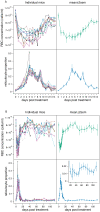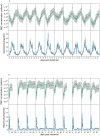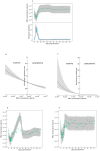Quantitative analysis of mechanisms that govern red blood cell age structure and dynamics during anaemia
- PMID: 19557192
- PMCID: PMC2694369
- DOI: 10.1371/journal.pcbi.1000416
Quantitative analysis of mechanisms that govern red blood cell age structure and dynamics during anaemia
Abstract
Mathematical modelling has proven an important tool in elucidating and quantifying mechanisms that govern the age structure and population dynamics of red blood cells (RBCs). Here we synthesise ideas from previous experimental data and the mathematical modelling literature with new data in order to test hypotheses and generate new predictions about these mechanisms. The result is a set of competing hypotheses about three intrinsic mechanisms: the feedback from circulating RBC concentration to production rate of immature RBCs (reticulocytes) in bone marrow, the release of reticulocytes from bone marrow into the circulation, and their subsequent ageing and clearance. In addition we examine two mechanisms specific to our experimental system: the effect of phenylhydrazine (PHZ) and blood sampling on RBC dynamics. We performed a set of experiments to quantify the dynamics of reticulocyte proportion, RBC concentration, and erythropoietin concentration in PHZ-induced anaemic mice. By quantifying experimental error we are able to fit and assess each hypothesis against our data and recover parameter estimates using Markov chain Monte Carlo based Bayesian inference. We find that, under normal conditions, about 3% of reticulocytes are released early from bone marrow and upon maturation all cells are released immediately. In the circulation, RBCs undergo random clearance but have a maximum lifespan of about 50 days. Under anaemic conditions reticulocyte production rate is linearly correlated with the difference between normal and anaemic RBC concentrations, and their release rate is exponentially correlated with the same. PHZ appears to age rather than kill RBCs, and younger RBCs are affected more than older RBCs. Blood sampling caused short aperiodic spikes in the proportion of reticulocytes which appear to have a different developmental pathway than normal reticulocytes. We also provide evidence of large diurnal oscillations in serum erythropoietin levels during anaemia.
Conflict of interest statement
The authors have declared that no competing interests exist.
Figures





 .
.


 in bone marrow. These are released into the circulation at a rate
in bone marrow. These are released into the circulation at a rate  . All reticulocytes are released by age
. All reticulocytes are released by age  , and have a maturation time of
, and have a maturation time of  hours. RBCs are randomly cleared at a rate
hours. RBCs are randomly cleared at a rate  and have a maximum lifespan of
and have a maximum lifespan of  days. Not to scale.
days. Not to scale.
Similar articles
-
Comparative proteomics reveals deficiency of NHE-1 (Slc9a1) in RBCs from the beta-adducin knockout mouse model of hemolytic anemia.Blood Cells Mol Dis. 2011 Aug 15;47(2):85-94. doi: 10.1016/j.bcmd.2011.03.008. Epub 2011 May 18. Blood Cells Mol Dis. 2011. Retraction in: Blood Cells Mol Dis. 2012 Feb 15;48(2):145. doi: 10.1016/j.bcmd.2011.12.007. PMID: 21592827 Retracted.
-
Characterization of the iron transporter DMT1 (NRAMP2/DCT1) in red blood cells of normal and anemic mk/mk mice.Blood. 2001 Dec 15;98(13):3823-30. doi: 10.1182/blood.v98.13.3823. Blood. 2001. PMID: 11739192
-
The quantification of reticulocyte maturation and neocytolysis in normal and erythropoietin stimulated rats.Biopharm Drug Dispos. 2014 Sep;35(6):330-40. doi: 10.1002/bdd.1902. Epub 2014 Jun 27. Biopharm Drug Dispos. 2014. PMID: 24888906
-
[Counting reticulocytes: new importance of an old method].Med Klin (Munich). 2010 Aug;105(8):538-43. doi: 10.1007/s00063-010-1092-9. Epub 2010 Sep 8. Med Klin (Munich). 2010. PMID: 20824411 Review. German.
-
Not all red cells sickle the same: Contributions of the reticulocyte to disease pathology in sickle cell anemia.Blood Rev. 2020 Mar;40:100637. doi: 10.1016/j.blre.2019.100637. Epub 2019 Nov 5. Blood Rev. 2020. PMID: 31735458 Free PMC article. Review.
Cited by
-
Deep-coverage rhesus red blood cell proteome: a first comparison with the human and mouse red blood cell.Blood Transfus. 2010 Jun;8 Suppl 3(Suppl 3):s126-39. doi: 10.2450/2010.020S. Blood Transfus. 2010. PMID: 20606743 Free PMC article.
-
Mitochondrial DNA is critical for longevity and metabolism of transmission stage Trypanosoma brucei.PLoS Pathog. 2018 Jul 18;14(7):e1007195. doi: 10.1371/journal.ppat.1007195. eCollection 2018 Jul. PLoS Pathog. 2018. PMID: 30020996 Free PMC article.
-
Fitness costs of disrupting circadian rhythms in malaria parasites.Proc Biol Sci. 2011 Aug 22;278(1717):2429-36. doi: 10.1098/rspb.2010.2457. Epub 2011 Jan 5. Proc Biol Sci. 2011. PMID: 21208950 Free PMC article.
-
Examining the Reticulocyte Preference of Two Plasmodium berghei Strains during Blood-Stage Malaria Infection.Front Microbiol. 2018 Feb 20;9:166. doi: 10.3389/fmicb.2018.00166. eCollection 2018. Front Microbiol. 2018. PMID: 29515528 Free PMC article.
-
The role of spatial organization of cells in erythropoiesis.J Math Biol. 2015 Jan;70(1-2):71-97. doi: 10.1007/s00285-014-0758-y. Epub 2014 Feb 5. J Math Biol. 2015. PMID: 24496930
References
-
- Mackey MC. Unified hypothesis of the origin of aplastic anaemia and periodic hematopoiesis. Blood. 1978;51:941–956. - PubMed
-
- Bélair J, Mackey MC, Mahaffy JM. Age-structured and two-delay models for erythropoiesis. Math Biosci. 1995;128:317–346. - PubMed
-
- Mahaffy JM, Bélair J, Mackey MC. Hematopoietic model with moving boundary condition and state dependent delay: applications in erythropoiesis. J Theor Biol. 1998;190:135–146. - PubMed
-
- Pujo-Menjouet L, Mackey MC. Contribution to the study of periodic chronic myelogenous leukemia. C R Biol. 2004;327:235–244. - PubMed
-
- Colijn C, Mackey MC. A mathematical model of hematopoiesis I. Periodic chronic myelogenous leukemia. J Theor Biol. 2005;237:117–132. - PubMed
Publication types
MeSH terms
Substances
Grants and funding
LinkOut - more resources
Full Text Sources
Medical

